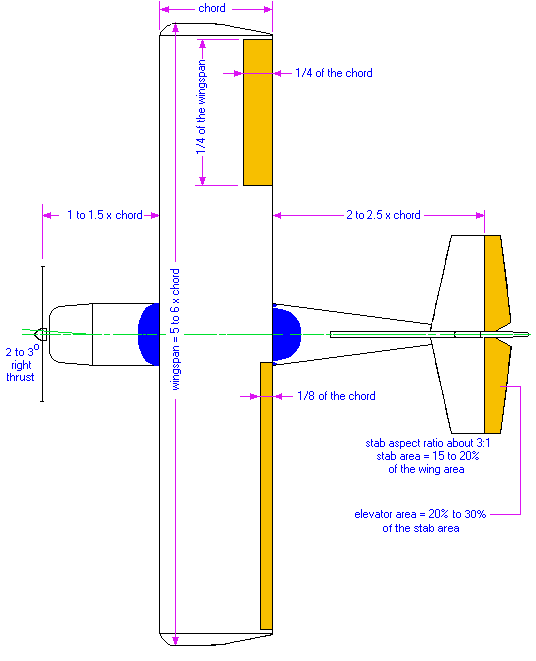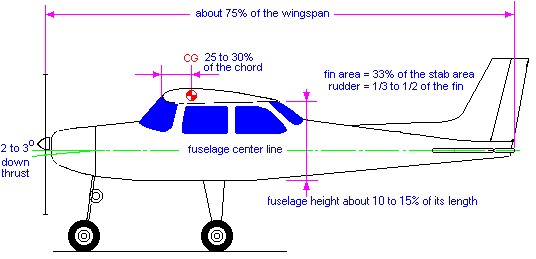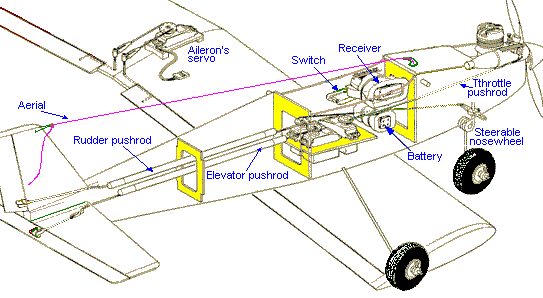Trainer Design
By reducing the dimensions of a full-sized aircraft proportionally, a scaled model will be obtained, however, it seldom becomes an easy flying one. The main aerodynamic differences between a model and a full-sized aircraft are originated from the boundary layer, the thin layer of air close to the wing < surface that is slowed down by skin friction.
According to Osborne Reynolds, there are two main types of flow: The laminar and the turbulent.
Which flow type occurs within the boundary layer at a given point of the wing's surface depends on the wing's form, the surface's roughness, the chord lenght, the airspeed and the ratio of density to viscosity of the air. Reynolds combined all those factors (except the surface condition) into a non- dimensional number known as Reynolds Number Re.
Re = (air density/air viscosity) x air speed x wing chord
Air viscosity is measured in kilograms per meter per second. The standard value is: 0.0000179 kg/m/sec. For instance, a wing with a chord of 0.1 meters at a airspeed of 10 m/sec and with the standard air density and viscosity will have the following Re:
At low airspeed and small wing chord (as with a model aircraft) the air viscosity is a dominant factor, whereas with the full-sized aircraft the viscosity effects of the air are smaller, and the aircraft's mass inertia becomes more dominant. That's why one should not expect a scaled model aircraft to have the same flight characteristics as its larger counterpart.
A large wing that is flying fast has a higher Re and thinner boundary layer than a small wing that is flying slow. The boundary layer is thinnest when its flow is laminar and thickens when it is turbulent. The turbulent flow may separate from the wing's surface, producing more drag and decreased lift, which may lead to stall. Thus, a low Re wing is more likely to suffer from laminar separation and to stall sooner than a wing with high Re.
The area of the flying surfaces (wings, fin and stabiliser) as well as the control surfaces (elevator, rudder and ailerons) should be proportionally larger in the model aircraft in order to obtain more controllable flights and landings. Wing loading is also more critical with smaller models. That means, a bigger model allows for greater wing loading than a smaller one.
Some basic rules of thumb may be followed when designing an easy flying trainer model according to the pictures below:


One may start by choosing the desired wing chord or wingspan from which all other related dimensions may be calculated. With high wings the dihedral angle is typically between 3 to 6 degrees. Dihedral should be lower when using ailerons (up to 3 deg). Although not strictly needed, a washout angle between 3 to 5 degrees is advisable in order to improve stall characteristics. The ideal incidence and motor thrust angles are usually found by trial and error. Initially, one may start with 2 to 3 degrees down and right thrust. The wing's and stabiliser's incidence may preliminary be set at zero, and may be changed during test flights. Flat bottom wings may need more down thrust than symmetrical and/or semi- symmetrical ones.
Landing gear placement on a tail dragger should have the axle coincident with the leading edge of the wing, whereas on a tricycle the main gear should be slightly aft of the CG balance point in order to get easier take-offs.
A tail-heavy aircraft will be more unstable and susceptible to stall at low speed e. g. during the landing approach. A nose-heavy aircraft will be more difficult to takeoff from the ground and to gain altitude and will tend to drop its nose when the throttle is reduced. It also requires higher speed in order to land safely.
|
Recommended Engine Size vs
Wing Area |
|||
| c. c. | c. in. | area sq. dm | area sq. in. |
| 0.8 | .049 | 12 - 16 | 200 - 250 |
| 1.6 | .10 | 15 - 22 | 250 - 350 |
| 2.5 | .15 | 20 - 30 | 300 - 450 |
| 4.0 | .25 | 26 - 32 | 400 - 500 |
| 6.7 | .40 | 32 - 45 | 500 - 700 |
| 10 | .60 | 38 - 55 | 600 - 850 |
As for the airfoil one should consider that a flat bottom wing gives high lift at upright flight but poor lift at inverted flight. Flat bottom wings are mainly used in slow and relatively light powered models. Semi - symmetrical airfoils are usually a good compromise giving almost the same lift at both upright and inverted flight. Symmetrical airfoils are intended for aerobatic models as it behaves equal at both upright and inverted flight.
The control surfaces' max throws also have great effect on the flight stability. With a too much throw the model will respond too quickly and may be difficult to control, whereas too little throw will result in poor control, especially at low landing speed. Typical throw settings measured at the control surface trailing edge are:
Elevator and Ailerons 6mm (1/4") up and down.
Differential Ailerons (recommended with flat bottom wings) 8mm (5/16") up and 4mm (5/32") down.
Rudder 10mm (3/8") left and right.
Those figures are just guidelines and some minor changes may be done during test flights. Faster models will require lower throw settings.
To increase the control surface throw, move the push rod to the hole on the control horn that is closer to the control surface and/or move the push rod to the further out hole on the servo arm. Some transmitters have dual rate facility, which allows the pilot to change the max throws to suit the flying speed.
The picture below shows a typical radio installation. Both the battery and the receiver are wrapped upp in soft foam to damp the motor vibrations.

The material and construction methods depend on the model itself, personal preferences and on materials and tools available. Given enough power, almost anything can be made to fly - the question is how. One should also bear in mind that landing is an inevitable part of the flight. An aircraft with high wing loading requires higher thrust and higher landing speed to avoid stall. Thus, one should strive to build as light and as strong as possible. Typical wing loading with a 150cm wingspan (60 in) model is about 60g/sq.dm (19-oz/sq. ft). This value may be slightly higher with bigger models but should definitely be lower with smaller ones.
Wing loading is the aircraft's weight divided by the wing area.
